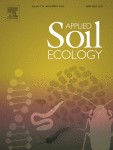Ver ítem
- xmlui.general.dspace_homeCentros Regionales y EEAsCentro Regional Salta - JujuyEEA SaltaArtículos científicosxmlui.ArtifactBrowser.ItemViewer.trail
- Inicio
- Centros Regionales y EEAs
- Centro Regional Salta - Jujuy
- EEA Salta
- Artículos científicos
- Ver ítem
Short-term service crops affect the spatial organization of soil aggregates, microbial C–N biomass, and microbial activities in a degraded monoculture system
Resumen
Service crops are grown to provide ecosystem services, such as the ability to increase soil organic matter and fertility. Also, they reduce erosion processes, weed control, disease regulation, water purification, soil biodiversity, and physical restoration. The physical arrangement of elemental particles in soil aggregates controls many ecosystem functions such as soil stability and carbon sequestration. This study aimed to analyze the short-term effect
[ver mas...]
Service crops are grown to provide ecosystem services, such as the ability to increase soil organic matter and fertility. Also, they reduce erosion processes, weed control, disease regulation, water purification, soil biodiversity, and physical restoration. The physical arrangement of elemental particles in soil aggregates controls many ecosystem functions such as soil stability and carbon sequestration. This study aimed to analyze the short-term effect of including different service crops on the soil aggregate dynamics in a degraded common bean monoculture system and how it influences the rhizospheric microbial activity, carbon, and nitrogen microbial biomass. Here, we measured soil water-stable aggregates, particulate and associated organic carbon, soil microbial biomass, microbial activity, service crop aerial biomass, and cash crop yield in bulk soils during the 2020/2021 and 2021/2022 agricultural cycles. Soil samples from depths of 0–10 cm from five management treatments (annual service crop/common bean) were analyzed under no-tillage: 1) Oat (O) = Avena sativa/common bean; 2) Wheat (W) = Triticale/common bean; 3) Vetch (V) = Vicia villosa/common bean; 4) Melilotus (Me) = Melilotus alba/common bean; 5) common bean monoculture (M) = common bean without service crop. Additionally, two controls were analyzed: 6) Brachiaria perennial (BP) = Brachiaria brizantha perennial; 7) Native vegetation (NV). Service crops significantly increased aggregate stability, mean weight diameter, particulate matter and associated organic carbon, promoting the formation of large macroaggregates (0.25–2 mm and > 2 mm). This led to an increase in carbon stocks. Microbial activity expressed as hydrolysis of fluorescein diacetate and acid phosphatase activity, increased in the largest fraction for all service crops. Vicia improved surface residues; on average all service crops increased the common bean yield by 107.25 %. In summary, Vicia represents the best alternative as a service crop to improve the quality and health of degraded monoculture soils.
[Cerrar]

Fuente
Applied Soil Ecology 199 : 105419. (July 2024)
Fecha
2024-07
Editorial
Elsevier
ISSN
0929-1393
1873-0272 (online)
1873-0272 (online)
Documentos Relacionados
Formato
pdf
Tipo de documento
artículo
Proyectos
(ver más)
INTA/2019-PE-E1-I013-001, Restauración y/o mantenimiento de la provisión de servicios ecosistémicos para mejorar la productividad y/o rentabilidad de sistemas agrícolas del norte de Argentina
INTA/2023-PD-L03-I093, Fertilidad química, física y biológica del suelo: estrategias para mitigar y restaurar procesos de degradación
INTA/2023-PE-L03-I055, Abordaje para la prevención y mitigación de la degradación ambiental y la pérdida de biodiversidad en la Región NOA
Palabras Claves
Derechos de acceso
Restringido
 Excepto donde se diga explicitamente, este item se publica bajo la siguiente descripción: Creative Commons Attribution-NonCommercial-ShareAlike 2.5 Unported (CC BY-NC-SA 2.5)
Excepto donde se diga explicitamente, este item se publica bajo la siguiente descripción: Creative Commons Attribution-NonCommercial-ShareAlike 2.5 Unported (CC BY-NC-SA 2.5)


